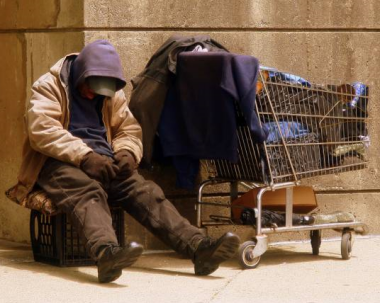
I recently received an e-mail telling me that America’s 10 poorest cities were – and mostly have been for many years – run by Democrats. I’ve seen this claim before, and decided to get to the bottom of this issue.
The e-mail cites the U.S. Census Bureau, 2006 American Community Survey of August 2007, so I went to their website and found a PDF of the survey mentioned. It’s 36 pages of statistics and it’s written like – well, like a government survey. But after a couple of hours of painful math (see how I sacrifice for you?), and cross-referencing back to the Internet to check on the governments of these cities, it does seem that the claims of the e-mail are correct – America’s 10 poorest cities are run by long-standing Democrat administrations.
But wait! There’s more! In trolling around the Internet I came across references to the allegation that the 10 poorest States were being run by Republicans, and that their fiscal policies were making and keeping people poor. Many of these pointed back to an article by CNN editorialist Jack Cafferty “What Does It Say That Most of the 10 Poorest States Are Republican?” posted to his blog back in September of 2011.
Conveniently Cafferty’s article cites no government study. It simply presents the claims of the author, and it’s quite short. But now I had a counter-point to the original claim. Could it be that the GOP can be driving States into poverty while the Dems are rotting major cities with their policies? I went back to the same survey mentioned above and found that indeed 9 of the 10 poorest States in America were run by Republicans. I kept searching and reading, but the two claims – Dems controlling the poorest cities backed by government census data, and GOP controlling the poorest states, backed by the same government census data – kept coming back to me.
Then I ran across this article on Forbes Magazine website which I believe explains why both of these statements might be true.
This isn’t a long article, nor is it hard to read – not like that U.S. Census Bureau survey – and it will provide you with an interesting alternative viewpoint and one possible explanation of what’s happening in 9 of 10 of America’s poorest states.
—–
“Are the 10 Poorest U.S. States Really Republican?”
By Dr. Mark W. Hendrickson, Contributing Editorialist, Forbes Magazine | June 7th, 2012
“Most of the 10 poorest states are Republican” is a quote of CNN’s Jack Cafferty. It appeared in his “Cafferty File” blog last September 22, and was accompanied by the opinion, this is “something the GOP can’t be too comfortable with.” Indeed, in an election year, you can bet that Democrats will try to make hay with those data.
My previous column made the case that Democratic Party policies have induced the impoverishment of America’s poorest cities. Turnabout is fair play. If Republican policies have led to the economic stagnation of entire states, whereas Democrats are only responsible for ruining cities, then the Dems might have the stronger campaign talking point. Let’s examine the 10 poorest states to see if Republicans are to blame for their relative economic standing.
The poorest states, based on per capita income, are, from first to last: Mississippi, Arkansas, Tennessee, West Virginia, Louisiana, Montana, South Carolina, Kentucky, Alabama, and North Carolina. Of these, exactly half—Arkansas, Kentucky, Montana, North Carolina, and West Virginia—have Democratic governors and three have Democratic majorities in the lower house of their legislature, so these state governments can hardly be classified as completely Republican. On the other hand, only North Carolina voted for Obama in 2008, so in that sense, these states may be leaning Republican.
A common analytical error is the “post hoc ergo propter hoc” fallacy—“after this, therefore because of this.” For example, chronic federal deficits became chronic in the 1960s. What changed in America at that time? Alaska and Hawaii were added to the union in 1959 and 1960, respectively; therefore, the erroneous assertion to follow is that we need only expel those two states from the Union to solve our deficit spending problem. Absurd, right? Similarly, we can’t facilely assume that the lower per capita incomes in the 10 poorest states were caused by Republican policies.
Looking at the list of the 10 poorest states, all except Montana are east of (or border on) the Mississippi River. That means they are older states. Those nine also happen to be concentrated in the South. This is significant: They were all slaveholding states. They focused on producing commodities, whereas the northern states produced more value-added goods, more manufactured goods, more capital-intensive goods. Combined with national policies that conferred economic advantages on the relatively industrialized, higher capitalized North—policies that created some of the friction that led to the Civil War—the South’s economic development lagged.
As is common in societies based on producing raw commodities, the Old South had an elite that owned the land and employed a poorly educated workforce to plant, tend, and harvest the crops. Historically, then, education was of less importance, and therefore emphasized less, in the South than in the North—a trend that contributed ongoing economic advantages to the North.
After the Civil War, Republican carpetbaggers from the North kicked around the defeated South, further widening the economic gap between the two regions. One political consequence was that the Deep South was monolithically Democratic for the next century. Only in the last generation, when the secular counterculture took over the Democratic Party, did many Southerners finally bury the distant past and register as Republicans.
In short, those nine erstwhile slaveholding states have been lagging behind the northern states economically for two centuries. Just because one generation of leaning Republican has not eliminated a disparity that was entrenched for centuries, it is not an indictment of Republicans.
As for Montana, whose people elect Democrats and Republicans to statewide office with almost equal frequency, its economic status has a geographical cause. Montana is remote and its climate is harsh; consequently, it has never attracted enough people to achieve an economic “critical mass” to advance much beyond the commodity-related businesses of farming, ranching, and mining. That is why it has lagged economically—not because of anything Republicans have done.
Another common mistake in economic analysis, seen often, for example, in the (irrational) rationale that liberals use when resisting cuts in marginal tax rates, is to adopt a static rather than dynamic view—to see life and economic conditions in terms of snapshots rather than as a motion picture. In the politically motivated attempt to blame Republicans for the lower incomes in the 10 poorest states, CNN’s Cafferty and Democrats have taken one snapshot—of the census’ income statistics—and combined it with another snapshot—of current political leanings—to create the impression that Republican policies make America poorer.
The more important factor is not the economic ranking of states at a point in time, but the overall trends. An important article by John Merline compared the economic performance of blue states and red states during the presidency of Barack Obama. The trend of economic indicators clearly favors Republican states. Democratic states have experienced lower growth in both jobs and income in the last few years. Home prices have fallen further in blue states, and their unemployment rates are higher. In other words, a dynamic economic analysis of the states casts a far more favorable light on Republican states than static analysis. Since real life is dynamic, not static, Republicans can make the stronger case about which party is best suited to lead the way to greater prosperity.
The most fundamental difference between the data that conservatives prefer—that the 10 poorest cities are longtime Democratic strongholds—and the data that liberals will be more inclined to cite—that the 10 poorest states are predominantly Republican, is that conservatives can point to actual policies that Democrats implemented that contributed to the impoverishment of the cities, while the liberals cannot point to specific GOP policies that have caused the poorer states to lag behind.
The Democratic case is illusory and circumstantial; the Republican case is solid and substantial. However, in a country where so many people are economically and historically illiterate, combined with the human proclivity whereby “a man hears what he wants to hear and disregards the rest” (Paul Simon, “The Boxer”), the Democrats may be able to score some points with a hollow argument. The Republicans, though, have the facts on their side.


